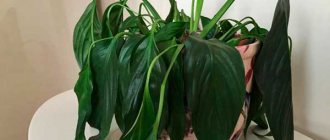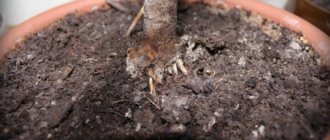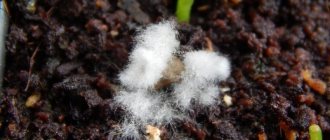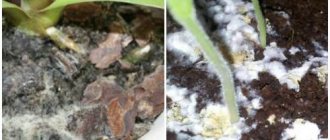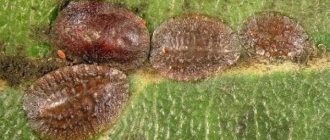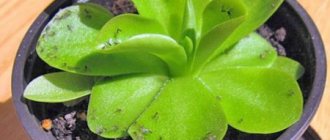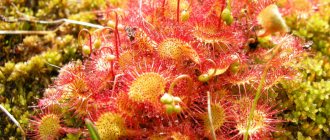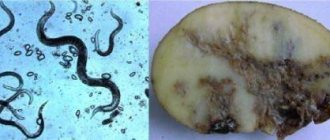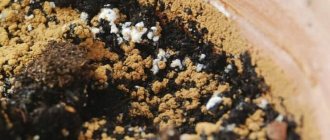Ants are ubiquitous insects that can be found not only in the garden or garden, but also in the house. They often prefer to live in flower pots, which causes inconvenience to gardeners. There are many ways to get rid of ants in a flower pot once and for all. You don’t even need to use special tools for this.
About the causes
Ants on flowers
Factors contributing to the appearance of ant outbreaks in flower pots are:
- neglect of regular cleaning: an overfilled garbage bin, the presence of food remains on the table surface or on the floor can attract various insects, including ants;
- ant eggs or the pests themselves can be brought into a living space when they come into contact with clothing or shoes;
- insects such as ants prefer to choose warm habitats for themselves, which is the reason for their rush into human housing (if there is no hygiene in an apartment or house, this will be an ideal place for their spread);
- a colony of ants can move into a neighboring apartment if one of the neighbors decides to start removing them.
Note. When ants enter an apartment, they settle in an indoor flower pot, where the conditions for their habitat are most favorable.
Why is this happening
Before looking for ways to remove ants from a flower pot, you need to find the reason for their appearance. Experts have proven the close symbiosis between ants and aphids. The latter prefers to use plant juice as a food source. Indoor flowers in pots are the optimal habitat. It is always warm there, moderately humid and all the plants have enough juice.
Ants themselves are capable of growing entire colonies of aphids, carefully caring for their representatives. For these insects, the sweet honeydew, which is secreted during the life of aphids, becomes the most delicious morsel. As a result, large colonies of both aphids and ants grow in flower pots on the window.
Ants in indoor plants
Also, the reason that ants appeared in flower pots could be the initially contaminated soil. It is often imported by flower growers from the forest.
Important!
Before starting the fight, you should carefully study the behavior of insects and determine their location.
Ignoring the problem threatens the rapid death of your favorite potted plants. After all, after an aphid attack, decorative flowers quickly begin to fade, stop growing and may finally die
Prevention of ants
You can prevent the occurrence of anthills on your garden plot by carrying out gardening activities, including:
- timely digging of the earth;
- if you remove old tree bark;
- placing plant residues in a compost heap during harvesting;
- refusal to plant linden and viburnum in the garden;
- sowing mint, garlic, onions and calendula around the perimeter of the site;
- ridding the land of weeds.
Mint on the site as prevention against ants
At home, you can prevent ants from appearing in the following ways:
- remove food from the table;
- do not leave dirty dishes;
- collect crumbs;
- get rid of stains;
- store garbage in a sealed bag;
- clean the house regularly.
In garden plots, in most cases, ants are not completely exterminated, only the necessary plantings are treated. The only exception is the situation when ants fall into the well. But if they enter domestic living spaces, they can harm both the property and the health of the owners of the house or apartment. In this case, fighting them is mandatory.
0 0 votes
Article rating
Why do ants live in flowers?
Ants appear in indoor flowers for the following reasons:
- irregular cleaning: a full trash can, leftover food on the table and floor - these are the things that attract the attention of pests;
- ants or their eggs can be brought into the house on clothes or shoes from the street;
- due to the fact that these pests are heat-loving insects, with the arrival of cold weather they rush into human housing; the ideal conditions for their stay are in the absence of hygiene;
- insects may come from a neighboring apartment, the owners of which have decided to get rid of pests.
Ants in a flower pot Once in an apartment, ants will definitely take a liking to a flower pot and settle in it. After all, it is in it that favorable conditions are created for pests to live.
There are several ways to get rid of annoying insects
- Fighting methods
- Prevention is easier than cure: methods of prevention
Red ants are called domestic ants, choosing warm rooms to build their nests.
They are omnivores, so they feed on food, insect remains, fabric, and insulation in electrical devices. These paths usually run along baseboards or in deep gaps between floor tiles. The ultimate goal of insects may be:
- Bucket with garbage.
- A cabinet with cereals, sugar, other bulk products and sweets.
- A sink where dirty dishes often accumulate.
- A pet food bowl that always contains food.
Ants in flower pots - how to get rid of them?
A good and environmentally friendly way to control insects is to spread sesame seeds around the plant. If you sprinkle sesame seeds on an anthill, the seeds of the plant become infected with a fungus. This helps to quickly get rid of the “womb” of insects.
However, this method is not entirely suitable for flower pots at home. Therefore, we offer you a simple and accessible method for which you will need:
- Large container or bath.
- Water.
- Plasticine.
- A plant in a pot with insects living there.
To get rid of ants in flower pots, follow these steps:
- Place the infested flower pot in a large container or tub filled with water. The pot itself must be completely filled and immersed in water.
- Leave the pot in the water for 30 minutes. During this time, the ants will either run away or drown.
Important! If the flower pot is too large and you cannot move it, then plug the drain hole with plasticine and water the pot very generously. Just as in the previous case, leave the plant for 30 minutes and then remove the plasticine.
- Remove old soil from the root system.
- Repot the plant using new soil.
Important! Remove soil with ants away from other indoor plants and dispose of it.
- Place the flower pot in its original place and make sure there is nothing nearby that might attract ants.
Important! Peretrum spray can help get rid of ants in a flower pot. The product must be used very carefully. First, dilute the peretrum spray with water (10 parts of the product to 90 parts of water), and then water the plant and leave it for 10 minutes to allow the water to drain.
Consequences of ants
At first there are not very many of them in the kitchen, and no significant discomfort is felt. But the housewife began to more and more often remove products from the cabinets that were clearly damaged and riddled with ant passages, and the tiny remains of these creatures were found everywhere, even on the dining table. Is there any danger for a person in the presence of such uninvited guests or is it just a simple inconvenience?
A kitchen that is not cleaned on time is a great place for uninvited “guests” to feast
They move everywhere: in sewers, landfills, and garbage containers. Of course, they carry this entire set of “joys” with them, spreading it to their environment.
Ants bite and, in addition to quite painful consequences, an insect bite can provoke severe allergies, as well as asthmatic manifestations in people predisposed to this disease.
In addition, negative consequences include hopelessly spoiled food, as well as the need to endlessly sort through and shake up the contents of kitchen cabinets, even the refrigerator, since these ubiquitous creatures very willingly settle there.
To prevent the appearance of unwanted insects, you should thoroughly clean your kitchen.
How to remove ants from flower pots
How to remove ants from flower pots
There is a list of removal methods if ants appear on flowers and how to fight them:
- The widely used well-known folk method of flooding is carried out by placing a flower pot in a large, deep container, which must be filled with water. If your household equipment does not have a container of a suitable size, the pot is filled to the top with water. After a few minutes, when faced with flooding conditions, the pests will almost stop fussing;
- Work on replacing the soil must be carried out correctly: the pot is turned over and the flower is carefully removed from it. Next, the entire root system is thoroughly cleaned and washed to remove eggs laid by ants;
- The method of applying repellents is to treat the pot and trunk with garlic or vegetable oil.
- The list of herbs that repel ants includes:
- sagebrush;
- mint;
- lavender;
- anise;
- parsley;
- tomato tops;
- basil;
- cinnamon;
- carnation;
- black pepper;
- red pepper.
Herbs for ants
Insects cannot tolerate the smell of the above herbs, which forces them to look for a new habitat.
Helpful advice. If it is impossible to replace the contaminated soil, it must be calcined by placing it in a preheated oven for 20 minutes. The soil can be used for its intended purpose after cooling.
- You can also catch ants by covering a flower pot with tape so that the sticky side faces outward;
- A soap solution for killing ants is prepared from 1 teaspoon of liquid soap dissolved in 0.5 liters of water. The resulting liquid is poured into a spray bottle and used to treat the flower planting by spraying. In addition, it is recommended to pour a little solution into the soil;
- You can exterminate ants by placing a mixture of oatmeal and honey near the container with the flower. Honey is a strong-smelling component that attracts ants, oatmeal is a poisonous substance for these insects, and if they eat it, they will immediately die;
- When ant pockets appear in a flower pot, you can sprinkle the soil with millet. When eating cereal, the ants will die, since due to the swelling of the millet inside the insect, its body is deformed;
Note. The method of killing ants using millet is considered the most suitable for use in gardens.
- A solution of camphor oil for removal is prepared by diluting 10 drops of this essential component in 1 liter of warm water. The resulting liquid is used to water diseased flowers. The treatment should be repeated 3 times.
Types of house ants and their habitats
Ants in the house
Not all types of insects coexist with humans. Black, red or yellow ants settle in houses. They are big fans of damp and warm rooms. They can be found in kitchen cabinets on shelves with cereals, between loose tiles from the wall, behind baseboards, in trash cans with food scraps, under carpets and furniture.
In the summer they crawl into the house through open windows and doors. They are attracted by the smells of food and the opportunity to get ready-made food without much effort. You can often observe a chain of moving insects on the windowsill. Having seen such a picture, you urgently need to take appropriate measures and quickly scare away the ants from the house, otherwise you will have to wait a very long time to get rid of the growing colony of invaders.
During the cold season, they crawl into the house for a different reason. Stove or gas heating of a living space is a constant source of heat, so ants do not need to dig deep underground tunnels and hibernate. They live in the cracks of wooden floors, in dark corners under the bathroom, or nest comfortably under the kitchen sink.
House ants
If small red ants appear in the house randomly and do not stay for long, then the same cannot be said about red or pharaoh ants. These small pests settle in residential premises purposefully. They never build anthills, but inhabit dark places, such as:
- cracks behind baseboards;
- joints between tiles;
- hollow spaces in blinds;
- broken electrical appliances;
- a pile of old newspapers or magazines.
Ants multiply quickly in the house. Their number can reach up to three hundred thousand. The queen, together with some of the worker ants and males, creates a new nest, budding off from the rest of the colony. Usually the nests are located close to each other, but exist autonomously.
If it is possible to exterminate the insects of one nest, this will not significantly affect the life of the entire colony, since there can be several dozen such settlements, and the pharaohs can restore their numbers in a short time. So it’s quite difficult to quickly get rid of such an invasion in a private home.
Black or garden ants are also a real disaster if they are found in a private home. They multiply quickly and take over territory, like the rest of their relatives. It is impossible to hide anything from black ants: insects penetrate into all cracks, food products, even if they are sealed in bags, damage electrical appliances. They carry pathogenic bacteria and, in defense, can bite painfully.
Fighting insects with various means and baits
Nowadays, in stores that sell flowers, on the market, or via the Internet, you can buy chemicals or buy traps that will help you get rid of uninvited guests - ants - at home.
Permethrin
This is a product that is used to treat the soil at home and outside.
Insects eat it, and their nervous system is affected. Insects die due to paralysis.
Permethrin can be purchased as an aerosol or powder.
Before applying the drug to a flower at home, carefully read the instructions. This product is harmful to humans. Do you want to protect yourself?
Wear gloves, make sure that the drug does not get on the mucous membranes of the mouth or eyes. Warn children that this is poison and should not be handled.
If by chance someone at home or even a pet swallows permethrin, rinse the mouth of the child, dog or cat, etc. with plenty of water. Go to a doctor or veterinarian immediately.
Lures
Using baits at home, you can destroy the entire colony. Most often, the bait contains proteins or sugar, tasty oil.
The insecticide must be poured into the bait. The block must be closed and placed on a windowsill or other place near the flower. Before using poison, read the label on it. This product should be safe for children and pets.
The bait helps remove parasites and contains active substances such as:
- boric acid;
- hydramethylnon;
- avermectin;
- fipronil.
Do you want to completely destroy all insects? Do not purchase baits with permethrin or cyfluthrin for home use. The poison in them is potent. Some worker ants will eat it and quickly die, and the colony will continue to develop.
Cover the soil with diatomite
Diatomite is an insecticide (organic) that has a mineral base.
Its consistency is similar to flour. They need to sprinkle the soil around the flower in the pot.
The worker insects will eat the diatomaceous earth and die within half an hour.
The substance can be wetted, but it will be less effective. After watering the flower, the appearance of dew or rain, the poison can be reused.
People should not inhale diatomaceous earth. You can wear a gauze bandage when working with it.
Diatomite is stored in a bag well packed. So it will not harm you, your household and animals.
Soap
To combat insects in an apartment, you will need 1 tbsp of mint soap. l. and 0.5 liters of water. The solution is poured into a spray bottle and the flower is sprayed with it.
In the bathroom, attach a hose to the faucet and use a water jet to wash off the ants from the leaves and stems. Garden flowers are treated similarly.
Sweet poison
Another effective way to get rid of pests in flower pots is to prepare a treat that can kill annoying ants. Millet and honey are used for this. It is necessary to mix the two ingredients and place them on a plate next to the infected plant. The sweet component of the product will definitely force insects to eat it, and the digestive system of six-legged animals is not able to digest the cereal. As a result, all individuals that have tasted the delicacy will die and the flowers will be able to fully grow and develop.
Water hazards made from old tires
The principle of operation is simple: a moat of water is created around the bush. No pests can cross it. Such a barrier is a reliable protection in cases where peonies are surrounded by ants.
Making a barrier is not difficult. Required:
- knife;
- old tires;
- water.
Procedure.
- Cut the tire lengthwise.
- Place one half on the bush.
- Place the tire on the ground, pit side down.
- Fill with water.
Such a barrier will not only prevent ants, aphids and other pests from appearing on peony flowers, but will also moisten the base of the plant.
Poisonous insect sprays
To save peonies from ants, you can spray the plant and the soil underneath with chemicals.
Yes, they can harm pets, birds and even humans, but if you choose the product wisely, you can avoid poisoning.
Another disadvantage of this method is that the ants will return very quickly. If you treat peonies with various chemicals, the effect will last until the first watering or rain.
Strength of smell
Ants have a fairly developed sense of smell to sense food over long distances. Therefore, if there are ants on flowers, you can use some plants.
On a note!
Ants cannot stand the smell of wormwood, mint, parsley and tomato tops. You can simply place these plants on the windowsills near flower pots, and the pests will quickly leave the occupied area.
Mint (Mentha sp.)
The most effective plants against ants are all types of mint. Especially peppermint (Mentha piperita) produces an extremely unpleasant odor for ants. The main role is played by menthol, which has an intoxicating effect on ants. Peppermint grows best in semi-shaded, moist areas.
It can be grown in pots on terraces and balconies, which will also protect these places from insect invasion. Despite its many benefits, mint does have a drawback. mint planted in a vegetable garden or garden grows very quickly thanks to underground rhizomes and can become an unpleasant weed in a short time.
That's why you need to keep an eye on its growth.
Tansy (Tanacetum vulgare)
The second plant that effectively repels ants from the garden is common tansy. Tansy is a wild plant that can be found in meadows near roads and fields. Previously, it was grown in gardens as an ornamental plant and herb.
Tansy - emits a strong, fragrant odor similar to camphor. From tansy we can also prepare liquid manure, infusions and extracts that will be useful in the garden to combat other pests (for example, aphids).
Just like mint, tansy is a very expansive plant and requires control.
Rosemary (Rosmarinus officinalis)
Plants for ants - rosemary, an indispensable assistant in the fight against insects. Rosemary produces a camphor-like aroma similar to pine, which effectively rids the garden of ants and other insects. Rosemary has many culinary uses.
Planted in a pot on the kitchen window it will discourage ants. It likes sunny and warm places, as well as light and permeable soils. Rosemary does not overwinter in our climate, so it is grown in gardens and vegetable gardens as an annual plant.
However, ant repellent plants grown in pots can overwinter in a room and keep you ant-free for many years.
Marjoram (Origanum majorana)
Marjoram is a very famous spice and herbal plant that will discourage ants from creating nests in its vicinity. Ants hate the smell of marjoram. It needs to be grown in a sunny, wind-protected place, in light and fertile soil.
You can plant it next to flower beds and with vegetables, especially brassica - an ornamental cabbage, for which this neighbor will bring a positive effect. You can also make an extract from marjoram that is used to apply to the trails of wandering ants. To prepare it, you must pour 10 g.
dried marjoram herb with 10 liters of water and let it stand for one day. It should be used immediately after preparation.
Thyme (Thymus vulgaris)
Thyme is a well-known medicinal plant and spice whose smell is not liked by ants. Thyme can reach a height of about 30 cm, has small leaves and small purple or white flowers.
You can plant it along paths, flowerbeds and beds, or plant it in pots that can be moved around. It produces a less intense odor than other ant repellent plants, but it is very effective.
Soil replacement
Replacing soil when infested with ants
This method is suitable if the pest has already lived in the soil being used:
- To get rid of it, you need to remove the flower along with the soil from the pot.
- Free the roots from soil as much as possible.
- Pour boiling water over the contaminated soil from the pot and allow to cool. In this case, all individuals die, including their eggs and larvae.
It is also possible to do it in another way so as not to disturb the plant too much. Place the flower pot in a large container of water so that the liquid completely covers it. Let it sit for a while. If there are ants in the ground, they will definitely try to escape. Since pests cannot swim, they will quickly die.
Important!
After the procedure, be sure to let the soil from the pot dry to avoid rotting of the root system.
Flood
If ants have attacked a flower, then to get rid of them, it is necessary to flood their home. To do this, place the flower pot in a deep, large-diameter container and fill it with water. If this is not possible, you should close the water outlet holes and fill the pot to the top with water. The bustle of insects will become noticeable within a few minutes.
Application of repellents
Treating the pot and stem of an indoor flower with garlic or vegetable oil will help remove ants. You can also place a sprig of wormwood, mint, lavender, anise or parsley in the place where pests accumulate. The smell of these plants is not to the liking of insects, which will force them to go in search of new housing. Tomato tops have similar properties.
The aroma of basil, cinnamon or cloves will repel ants from the flower. Insects are afraid of black and red ground pepper. It is enough to scatter any of these spices near the pot, and the ants will leave the flower forever.
Destruction of ants in flowers
Camphor oil
Camphor oil is another effective remedy against pests in the soil. It is enough to dilute 10 drops of camphor oil in 1 liter of warm water and pour the resulting solution over the infected flowers. To achieve maximum effect, the procedure is repeated 2-3 times.
On a note!
Regular cleaning of the apartment will help protect your indoor flower from pest invasion.
Tape traps
Regular tape will help reduce the number of ants at home. It is enough to paste it over the edges of the flower pot, as well as the flowerpot, with the sticky side facing out, and the insects scurrying here and there will certainly fall for this trick.
Special preparations
If there are ants in your indoor flowers, you can also fight them with targeted insecticides. The stores offer solutions that need to be used to treat the soil in pots. Poison sticks are also available. To use them, it is enough to insert an insecticide into the ground.
Special baits have proven themselves well. This is one of the most popular remedies. You can buy them in the store, or you can prepare them yourself. To do this, simply mix sugar, honey or other sweets with a small amount of boric acid. Roll into balls and place in ant paths.
Thus, the fight against ants in home flowers has positive results from the very beginning. The main thing is to take action as quickly as possible, before the population spreads and affects all domestic vegetation.
Varieties of midges
Winter is the season of active settlement of unauthorized “tenants” into human homes. At this time, indoor plants are especially vulnerable, which is taken advantage of by dipteran parasites. How to get rid of flower flies? The question is not easy, because their population numbers hundreds of varieties. Before ridding your green pet of the threat, you need to determine the type of pest, its habits, modes of existence, and weak points. Only then will the fight against him be crowned with success.
White
Small white insects, two millimeters long, resemble aphids. Begonia, fuchsia, orchid and other soft-leaved flowering plants are their favorite habitat. Sometimes a whole cloud of two-winged midges swarms over a flower, which has three names:
- White midge.
- Shield.
- Whitefly.
Flower growers consider the whitefly the most dangerous enemy for their clients, and therefore they are constantly solving the problem of how to get rid of these flies in a flower pot.
Female white midges are very fertile, laying 300 eggs, attaching them to flower stems. Adults do not live long (a month), but midges cause significant damage to indoor plants. The scale insect feeds on leaves, under which it hides, gradually eating its “shelter”. People, without knowing it themselves, help the dipteran parasite live freely. What's in their house:
- no ventilation;
- increased moisture levels;
- too warm;
- There is almost no space between flower pots.
Frequent and abundant watering of flowers also causes harm. Houseplants can become sick and begin to infect each other. White midges willingly help them with this, flying from one pot to another.
Black
Black midges (sciarids), partial to aloe, ficus, azalea, Decembrist, orchid and other house flowers, have another name - fungus gnats. Unprepossessing in appearance, they cause quite a lot of trouble for people, constantly ending up in a cup of tea or any other drink, or in food. At the same time, they do not like human food, but end up in it solely out of their own stupidity.
Removing larvae is problematic, and therefore it is better to prevent the appearance of black parasites in your home. To do this you need:
- Do not take soil for flowers from a flower bed or garden. The soil may be contaminated. It is necessary to use the services of special stores.
- If you notice harmful insects in the substrate, you should remove the pot away from other flowers and quickly replant the plant.
- Monitor the condition of the root system; it should not rot. Decaying organic matter attracts sciarids no less than soil oversaturated with water. It is necessary to remember about moderate watering and suitable drainage.
If you are forced to replant a houseplant, you need to remove the dead roots and moisten the living ones with a weakly concentrated solution of potassium permanganate.
Earthen
Microscopic - from 1 to 4 millimeters - the creatures belong to the family of small arthropods (collembolas). They have two names: springtails and duras, in common parlance - earthen fleas. Wet substrates are places of permanent habitat. The midges are tiny, and they constantly jump, but scientists still counted them. There are more than 3,500 varieties on earth. Only a few “live” with people, living in flower pots. Characteristic features of the earthen flea:
- the body is elongated, white;
- Podura has a special jumping fork that allows her to jump;
- starts in acidified soil; its appearance in a flowerpot indicates that the root system has begun to rot;
- springtails accumulate on the surface of the soil, as well as under the flowerpot, on a wet tray;
- after abundant watering of the plant, white midges swim in the resulting puddle, bouncing dashingly on the water surface.
Ground fleas do not cause any particular trouble for flowers. But a large population can cause damage to the root systems of plants, especially young Saintpaulias and seedlings.
Kitchen products
To get rid of ants, you can use products that you probably find in your kitchen.
This could be coffee grounds, pepper and other products, or a homemade trap with self-adhesive film.
Coffee grounds
For some reason, ants really don't like coffee grounds. They will avoid her. To get rid of them, sprinkle it on the soil in the pot and around the pot. Soon the insects will leave.
Spices and products that are on hand
Some mothers worry whether various toxic insect repellents will harm their children? They are safe, just follow the precautions.
Despite this, some housewives prefer natural repellers in the apartment. These include:
- baking soda;
- cinnamon;
- carnation;
- mint;
- basil;
- chili pepper or black powder.
One or more of these products needs to be drawn in a circle around the flower pot. Seal the windows. Gradually, the insects will leave the flower, and new ones will not get into it.
Millet
If ants have settled in flower pots, then simply sprinkle millet on the ground. The cereal will clog the ant passages, which will force the insects to leave their nest. There is another opinion on the use of this recipe. Ants, eating cereals, die due to the fact that the millet begins to swell inside them, deforming the body of the pests.
This method is more often used to control pests in the garden, but it is also quite acceptable for indoor plants.
Oatmeal with honey
The fight against ants in home flowers can be carried out using oatmeal and honey. They are mixed in a 1:2 ratio, the resulting mass is laid out near the flower pot. Ants have a big sweet tooth, so the smell of honey will quickly attract their attention. But oatmeal acts as a poisonous component, and insects will die if they eat it.
Video material
The most effective method of dealing with uninvited guests in the house is prevention. Follow our advice and be careful with flower boxes, especially outside the window. Don't let insects enter your home so you don't have to fight them.
The most effective method of controlling ants in the house is prevention. Well-sealed windows, cleanliness and proper storage of food. And also be careful with flower boxes outside the window.
Unpackaged food or leftovers are a haven for ants. They sense it from afar because they have an unsurely developed sense of smell.
They are guided by their outstanding sense of smell.
Ants choose suitable living conditions, which is why they sneak into houses. Usually they enter human habitation from a nest in a garden or vegetable garden during their travels for food. When they discover that it is not only warm outside your window (usually in early spring), but also enough food, they will move their entire nest to you without any problem.
Basically, when traveling on a wall or window sill, you will first discover that you have a convenient flower pot outside your window. This is an excellent home and it’s a matter of minutes for ants to move there.
Then, with their excellent sense of smell, they will determine that you have something good to eat. And then there is no reason to leave such a good place to live. And vice versa, if you make their life difficult, they will easily move their nest to another place.
A sufficient bait for ants is ordinary sweet candy.
The most important tip is to seal your windows and don't attract ants inside. Window sealing, of course, in the spring is a small problem, because that’s when we get rid of it and try to ventilate it more.
Thus, as a preventative measure, the only thing left to do is to clean everything that would attract ants into the house for food. Make sure the products are well packaged. Store sugar, flour, honey and other goodies for ants in sealed jars.[5]
Ants have no chance of getting into closed glass jars, while paper bags are easily chewed through. It is better to keep juices and sweet drinks in closed plastic bottles. However, the ant will also feed well on crumbs left on the table or scattered sugar.
Try "folk advice".
They are believed to be uncomfortable with cinnamon, basil, mint, and cookie powder. If you really don’t know what to do, try drawing a line on the ground with white chalk; the ants supposedly won’t be able to cross it.
If you sprinkle black or red hot pepper and table salt on the ant paths, they should not appear on you. You can sprinkle baking soda on the window sills near doors and windows; it also helps.
It is believed that ants cannot stand the smell of cloves (spices). If you place several clove heads in a room, then when the ants smell it, they will not return.
Toothpaste spread on ant paths gave good results. It is recommended to wipe the entire apartment with water to which a little vinegar has been added.
Tried and tested home remedies can be used as effective prevention. Since ants have a keen sense of smell, these products really help. Therefore, if you do not want or cannot seal the windows, sprinkle the window sill with something that the ants do not like, and they will leave. If they climb into your flower pots, you can water them thoroughly for a while; they don’t like always wet soil.
Chemistry last.
If tried and tested home remedies don't help, there are several chemical remedies that will kill the ant. There are gels, powders and other products on sale that are poured onto ant paths and into the corner of the room. The ants eat it and die. There are also ant traps that look like a small house. Their advantage is that they do not poison domestic animals along with the ants.
Experts in pest control.
Ants appear in several stages. In the fall, pharaohs - red or yellowish ants - come to apartments and houses to bask; in the spring, small black ants appear. They gather in groups near windows or doors, under window sills and gradually try to move into the house. They appear near heating appliances, risers and window sills; they can also get in through the hood.
Companies involved in disinfection are well aware that in the summer it is not so easy to get rid of ants crawling from the street. Two barriers should be made - mechanical and chemical. The mechanical one prevents ants from entering the house, and the chemical one destroys them inside. Plaster splashes, windows, doors, window sills and cracks in the plaster.
Radical freezing will free you.
DIY non-poisonous trap
You can make your own insect trap. It will be non-toxic from a self-adhesive film. Do it like this:
- cut out a self-adhesive ring of such a size that it tightly covers the flower pot;
- Remove the protective layer from the tape and place it with the sticky side facing out so that insects crawling past are caught in the trap. The pot will stand in the center of such a tape;
- The adhesive film should be changed when necessary.
Do you want ants to leave your home forever after treatment? Clean the kitchen thoroughly after meals, do not leave sweet jam, honey, fruit and other foods that attract insects.
Cover juices and compotes in jars with a nylon lid. Take out the trash regularly.
Disinfect and keep the apartment clean. New insects will not take root; using various means you can get rid of the old-timers.
Expected harm
Strange creatures in the house always make you wonder what to expect from them. Will they start attacking a sleeping person, tormenting a pet, destroying kitchen supplies or damaging furniture?
If you are especially careful, you will notice that the ants initially appeared in the kitchen. They are attracted to human food as food. They prefer juices, sweets, flour products, baked goods, and will not refuse meat, fish, or ready-made soup.
Insects crawl through trash cans, sewers, and other unpleasant and unsanitary places. Then they drag all the microbes on their paws into the house. In practice, such cases of severe illness from yellow ants do not occur.
Sabotage consists of spoiling food supplies and irritating the nervous system of the residents of the house. Living under the same roof with small annoying insects is not very pleasant and not hygienic from a sanitation point of view.
Protective plants
Ants do not like the smell of many strong-smelling plants, so this environmentally friendly method will allow you to drive them away from the territory by planting the following flowers and herbs in the garden plot or laying them out in dried form:
- marigold flowers and lavender;
- lemon balm, mint, valerian;
- nasturtium, rosemary;
- potato;
- dill, parsley, mustard and cilantro;
- anise, fennel.
Many gardeners use fragrant plants, planting them around the perimeter of the plot; you can plant mint or marigolds to protect against aphids and ants in the rows of the garden. You can also make decoctions from these herbs, and then spray them on insect sites.
In your home or dacha, you can drive away domestic aliens by placing bunches of dried herbs in the room and in cabinets. Lavender flowers and mint will not only repel ants, but will also create a pleasant aroma in the room.
Plants against pests Some plants that are useful for the garden are planted in the trunks of fruit trees: valerian, mint or marigolds will not only drive away insects, but will also be used by their owners as medicine. Wormwood is used in the same way against ants.
Repellent methods
Garden ants are sensitive to odors and this can be used to ward off unwanted guests.
Repellent plants
Able to repel ants:
- Tansy
- Parsley
- Anise
- Mustard
- Laurel
- Mint
- Valerian
- Marigold
- Carnation
- Onion
- Garlic
The stems and leaves of these herbs or cut cloves of garlic should be laid out along the ant paths, or the trunks of bushes and trees should be tied with these plants, where ants - carriers of aphids - should not be allowed. It is recommended to rub tree trunks with garlic. The ants will leave the unpleasant aroma, finding a more comfortable place for themselves. Valerian, marigolds and mint can be planted between the beds or in the near-trunk zone of trees (double benefit: they will scare away the ants and serve as a natural medicine)) It is also recommended to spray protected plants with an infusion of hot capsicum , mint or lavender, marigold or wormwood, infusion of onion peels
Handy repellents
Many summer residents have already tried these methods and are now sharing their findings. They suggest: Sprinkle ant paths and anthills
- wood ash
- ground cinnamon
- coarse salt
- tobacco dust
- soot
- bone meal
- red pepper
- a mixture of ash, highly crushed tree bark and lime
Place the head of a smoked herring directly on the anthill. They say that this neighborhood is so unpleasant for the ants that they leave their “home” place. Place potato peelings on the anthill and next to it. If there are enough of them, the ants will prefer to move in. Sprinkle corrugated cardboard 20-25 cm wide with a soot solution and cover the anthill with it for 2-3 days. Ants really don't like the smell of soot. Watering paths and anthills with urine (urine) They claim that this is a very effective method. The main thing is that there is enough urine for all the ants. But! There is evidence that urine inhibits the root system of a plant (it was said about indoor plants that were watered once a week according to the so-called Japanese method). The sheepskin is cut into long strips about 1 cm wide and raspberry shoots are tied at a distance of 13-18 cm from the ground (with the wool facing out). It is recommended to lubricate the strips with crude carbolic acid. The smell of this acid drives out ants and saves berry bushes. The following video describes a simple and effective method of repelling millet.
Attention! According to experienced summer residents, it is useless to throw tomato tops, mint leaves or finely chopped garlic on an anthill - the ants will simply take the source of the unpleasant odor away.
Processing of trunks
Treating trunks against insects
Trees should be sprayed several times throughout the warm season; use one of the effective options:
- To 400 g of black soap add 100 ml of kerosene, 2 tbsp. spoons of carbolic acid. Mix thoroughly and dilute in 10 liters of water. The composition is used to water anthills and spray garden crops. Birch tar is poured into the roots of trees. Together, these products protect the garden from pests.
- Pour 30 g of dried wormwood flowers, 300 g of fresh plant into 10 liters of water. Leave for a day. Spray wood and branches generously. The product protects against aphids, ants and many other garden pests.
- Fighting fruit trees with soda protects against aphids, making it impossible for ants to climb the crown. Dissolve 30 g of linseed oil in 1 liter of water. Soda is added in an amount of 5 g. Such folk methods of struggle give quick results and do not harm the garden. Baking soda is also used to control ants in the garden.
- Garden ants cannot tolerate Coca-Cola. Dissolve the drink in water in a ratio of 5:1. A large share comes from Coca-Cola. Spray the vegetation in the summer cottage.
Controlling aphids is a necessary measure. If these insects disappear from the plants, the ants will also move to more favorable areas.
About the effectiveness of the method
There is an opinion that traditional environmentally friendly methods of insect control are not effective. Experienced summer residents and gardeners say the opposite. With proper planting of natural repellents relative to other crops, there is a chance to completely protect the area from ants. The main thing is to know how to combine certain herbs with berry and fruit plants.
Most of the listed flowers and plants attract predatory insects to the site. Therefore, planting some plants allows you to protect your garden from several pests at once. This eliminates the need to use chemicals.
Herbs and flowers are gentle. Ants do not leave the “fragrant” territory so quickly. But there is no negative effect from garlic, rosemary or lavender. Therefore, every year, summer residents increasingly use natural repellents, leaving pesticides as a last resort.
Ants can destroy the harvest of cabbage and other fruits. They gnaw flowers, fruits on trees and berries. They spoil the roots of plants. Where there are insects, there are also aphids, which they feed on. If you do not start the fight in a timely manner, you can neglect the plot and lose the opportunity to grow vegetables.
Consolidate the result
Smells that repel ants After carrying out active measures, a reliable rear should be provided so that a new colony of ants cannot settle after a while.
It is necessary to seal all the cracks in the wall, the gaps between logs, in window sills, under baseboards. Do everything to prevent small insects from entering the house.
Since it is difficult to ensure complete isolation of the room, repellent substances should be used. It is better to expel uninvited guests using folk remedies.
- Place chopped garlic or whole cloves around the perimeter of the house, on window sills, behind furniture. Rub the arrows of winter garlic on the walls.
- Scatter cinnamon indoors. Suitable ground or in sticks. In the latter case, the smell lasts longer.
- Plants are laid out in the house - chamomile, peppermint, bouquets of wormwood, tansy, elderberry. In the absence of plants, you can use essential oils. They drop it into the water, rub it on the floor, walls, and leave it on a plate.
- Carry out general cleaning of the house using a vinegar solution. Ammonia has a similar effect.
If ants appear in a wooden house, it is necessary to identify the anthill, carry out disinfestation, and provide prevention
Since insects enter the house from the outside, attention should be paid to the garden area. Plant mint and calendula around the perimeter of the house, create beds with garlic
